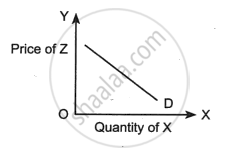Advertisements
Advertisements
प्रश्न
Demand for a good is termed inelastic through the expenditure approach when if (choose the correct alternative)
a) Price of good falls, expenditure on it rises
b) Price of the good falls, expenditure in it falls
c) Price of the good falls, expenditure on it remains unchanged
d) Price of the good rises, expenditure in it falls
उत्तर
Price of the good falls, expenditure in it falls
Demand for demand is inelastic through the expenditure approach when the price of the good falls and expenditure also falls.
APPEARS IN
संबंधित प्रश्न
| Group 'A' | Group 'B' | ||
| a. | Pen and ink | 1 | Quantity-price |
| b. | Revenue | 2 | Accident |
| c. | Insurable risk | 3 | Transfer income |
| d. | Unemployment allowance | 4 | Short period |
| e. | Reverse repo rate | 5 | Long period |
| 6 | Change in demand | ||
| 7 | Joint demand | ||
| 8 | Quantity * price |
Distinguish between ‘increase in demand’ and increase in quantity demanded of a good.
Demand deposits include (choose the correct alternative)
(a) Saving account deposits and fixed deposits
(b) Saving account deposits and current account deposits
(c) Current account deposits and fixed deposits
(d) All types of deposits
State the factors leading to fall in demand by an individual consumer
Write answers in ‘one’ or ‘two’ paras each.
What are the main determinants of aggregate demand?
Explain the following concepts or give definitions.
Demand
Fill in the blank with appropriate alternatives given below:
When less is purchased at the constant price, it is called _______ in demand.
State whether the following statement is TRUE and FALSE
Quantity demanded varies directly with price.
Give reason or explain the following statement.
Increase in demand indicates a rightward shift in the demand curve.
Answer the following question.
Discuss the relationship between the income of the consumer and demand for a commodity with respect to normal goods, inferior goods, and necessities.
We say that there is a decrease in demand when ______
Which of the following points are related to the 'Paradox of Thrift'?
Area under MC curve is equal to:
Which of the following statements is correct with respect to the correction of Excess Demand?
Which of the following statements is true?
Read the case study and answer the questions 97 to 100:
The Coca-Cola Company is an American multinational beverage company, with its headquarters in Atlanta, Georgia. The first company that conducted its operation in the soft drink industry was Coca-Cola. It is the world's largest non-alcoholic beverage company serving more than 1.8 billion consumers daily in more than 200 countries. It has a portfolio of more than 3,500 (more than 800 no or low-calorie) products. However, the company is best known for its flagship product Coca-Cola which was originally intended to be a patented medicine invented in 1886 by pharmacist John Smith Pemberton in Columbus, Georgia. The Coca-Cola products can be termed as normal goods and in August 2019 Coca-Cola introduced a new product into the market, that is, zero sugar where the demand has increased for the product in the market.
According to the council of the Australian Food Technology Association and Institute of Food Science and Technology, the Australian nonalcoholic beverages industry has been growing steadily, with a 2.3 percent increase in overall production in the year 2000 which amounts to 2.25 billion liters. However, in the re~ent years, sales of customary carbonated soft drinks have dropped as more and more customers become health conscious and move away from high-calorie sugary drinks. Soft Carbonated drinks. and other alcohol-free beverage manufacturers have also sensed the effects of intensifying competition from private-label soft drink makers. Nevertheless, sales of greater value energy and sports drinks have driven profit generation in the industry.
______ is the want to buy a product backed by purchasing power.
Demand deposits include:
The figure given below shows the relation between the quantity demanded for the good X and the price of the good Z. What type of goods are X and Z?

Read the passage given below and answer the questions that follow.
|
In India, Fixed deposits have long been a favourite investment choice of people, especially senior citizens, as it promise steady returns. It attracts those who are seeking a stable income. But it’s an illusion in the period of inflation. Inflation is the rate at which the general level of prices for goods and services rises, subsequently eroding the purchasing power of money. In simple terms, what money could buy today might not a few years down the line. Fixed deposits are financial instruments offered by banks where you deposit a lump sum amount for a fixed period at a predetermined rate of interest. Consider an investment of Rs 1 crore in a fixed deposit at a 6% annual interest rate and the annual rate of inflation is 5%. By the 10th year your pre inflation return is 1.79 crore, but post inflation it’s just 1.10 crore. The nominal value of investment in fixed deposits may appear to grow, inflation significantly diminishes their real value and purchasing power over time.
|
- What is the theme of the extract? (2)
- Differentiate between Demand pull and Cost push inflation. (2)
- What are the demand deposits and time deposits? (2)
- Since 1998 RBI has been using new measures of money supply, M0, M1, M2 and M3. Which one of these measures incorporates fixed deposit as one of its components? Mention the other components of that measure. (2)

